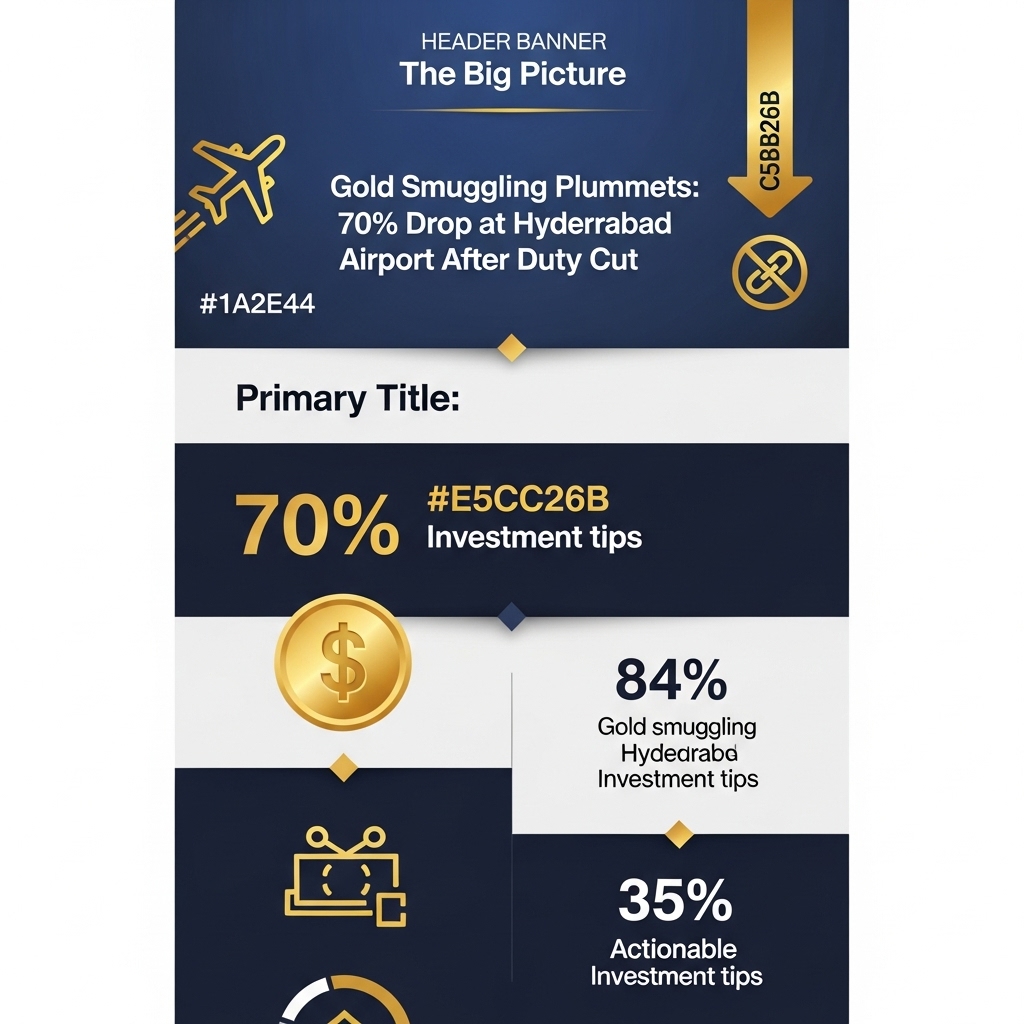Navigating the Golden Currents: How Policy Shifts Are Shaping Your Investments
In an era of economic uncertainty, gold continues to shine as a formidable safe-haven asset, a store of value, and a crucial diversifier in any astute investor’s portfolio. Its allure isn’t just in its intrinsic worth, but also in the intricate market dynamics that constantly evolve. Recent news from Hyderabad Airport, reporting a striking 70% decline in gold smuggling following strategic duty cuts, offers more than just a headline; it provides a vital lens into how government policies are directly influencing the gold trade and, by extension, your investment landscape.
While the dramatic reduction in illicit gold flow might seem like a local law enforcement success, its implications reverberate throughout the gold market, directly affecting investors like you. This shift towards a more transparent and legitimate gold trade has profound effects on supply chains, pricing stability, and ultimately, the potential financial benefits derived from gold holdings. In this deep dive, we’ll unpack what this significant drop in smuggling truly means for the Indian gold market and its ripple effects on global trends. We’ll explore how targeted policy changes, designed to formalize the gold economy, are reshaping market efficiency, liquidity, and overall investor sentiment.
Understanding these foundational shifts is paramount for navigating the contemporary gold market with confidence. A reduction in illicit trade fosters a more stable and predictable environment, potentially curbing price volatility and enhancing gold’s long-term appeal as a legitimate asset class. This development reflects broader efforts to integrate gold into the mainstream financial system, offering clearer pathways for both individual and institutional investors to capitalize on gold’s enduring value. Join us as we uncover the financial ramifications of this pivotal policy success and what it means for securing your golden future.
Gold Market Analysis and Key Insights
Key Market Insights
Impact of Duty Reduction on Investment Patterns
The 70% decline in gold smuggling at Hyderabad Airport following duty cuts reflects a significant shift in investor behavior. Lower import duties have made legal gold purchases more attractive compared to illicit channels, creating a more transparent investment environment. This regulatory adjustment has effectively reduced the premium associated with smuggled gold, encouraging investors to opt for legitimate market channels.
Regional Investment Behavior Changes
Hyderabad’s substantial smuggling reduction indicates changing regional investment preferences. South Indian markets, traditionally heavy gold consumers, are now accessing imported gold through official channels, suggesting increased confidence in regulated markets and formal financial institutions for precious metal investments.

Current Gold Market Trends and Data
Recent market data shows domestic gold prices stabilizing post-duty reduction, with premiums narrowing between international and local rates. Investment demand has shifted toward authorized dealers and banks offering gold coins and bars. Physical gold ETFs and sovereign gold bonds have gained traction as smuggling deterrents offer viable alternatives for portfolio diversification.
Investment Benefits and Considerations
Legal gold investments provide assured purity, authenticity certificates, and potential buy-back guarantees. However, investors should consider storage costs, insurance requirements, and liquidity factors. Digital gold platforms now offer convenient investment options without physical possession concerns.
Expert Recommendations
Financial advisors recommend allocating 5-10% of investment portfolios to gold as an inflation hedge and currency devaluation protection. Experts suggest considering systematic gold investment plans rather than lump-sum purchases, especially during volatile market conditions. Additionally, investors should verify dealer credentials and prefer hallmarked products to ensure authenticity and value retention.
The Hyderabad airport trend signals maturing gold investment markets, with regulatory reforms successfully channeling demand toward legitimate investment avenues while maintaining gold’s appeal as a traditional wealth preservation tool.
Gold Investment Strategies and Options
The recent 70% drop in gold smuggling at Hyderabad Airport, attributed to a duty cut, presents a nuanced scenario for investors. This event highlights the impact of government policy and market dynamics on gold’s attractiveness.
Gold Investment Options:
Investors can gain exposure to gold through several avenues:
* Physical Gold: This includes gold coins, bars, and jewelry. While tangible, it incurs storage and insurance costs and can be illiquid.
* Gold Exchange-Traded Funds (ETFs): These track the price of gold and are traded on stock exchanges, offering liquidity and lower transaction costs compared to physical gold.
* Gold Mutual Funds: These funds invest in gold mining companies, ETFs, or physical gold. They offer diversification but can be influenced by the performance of underlying assets.
* Sovereign Gold Bonds (SGBs): Issued by the RBI, SGBs offer a fixed interest rate, capital appreciation linked to gold prices, and are exempt from capital gains tax on redemption. They are a tax-efficient way to invest in gold.
* Digital Gold: Allows investors to buy small quantities of gold digitally, often held by custodians. It offers convenience and accessibility.
Risk Assessment and Portfolio Allocation:
Gold is often considered a safe-haven asset, performing well during economic uncertainty or inflation. However, its price can be volatile. A balanced portfolio typically allocates 5-10% to gold, depending on risk tolerance and financial goals. Diversifying across different gold investment avenues can mitigate specific risks associated with each.
Comparison of Investment Methods:
Physical gold offers direct ownership but has practical challenges. ETFs and digital gold provide liquidity and ease of access. SGBs are attractive for their interest component and tax benefits, making them a strong contender for long-term investors.
Market Timing Considerations:
The Hyderabad airport duty cut exemplifies how policy changes can impact gold demand and prices. Investors should monitor macroeconomic indicators, inflation rates, geopolitical events, and government policies to make informed decisions about when to enter or exit gold investments. While the duty cut might reduce the appeal of illegal channels, it could also signal a broader shift in gold market dynamics, warranting careful observation.
Market Performance and Outlook
Historically, high import duties on gold inadvertently fostered a lucrative black market, leading to rampant smuggling activities across Indian airports, including Hyderabad. Before the duty cut, smuggling incidents were frequent, and substantial gold seizures highlighted the scale of illicit trade driven by the significant price differential between domestic and international markets.
Currently, the reported 70% drop in gold smuggling at Hyderabad Airport after the duty reduction signifies a dramatic shift in market dynamics. This sharp decline indicates that the incentive for illegal trade has been substantially curtailed, making legitimate imports more competitive and encouraging a transition towards official channels. The immediate effect is a more regulated and transparent gold market at this entry point.
Looking ahead, if duty structures remain favorable, this positive trend of reduced smuggling is expected to persist and potentially extend to other major Indian airports. This could lead to a sustained increase in official gold imports, positively impacting government revenues and providing more accurate trade data. However, the broader economic factors influencing gold prices, such as global inflation rates, interest rate fluctuations, the strength of the US dollar, and geopolitical uncertainties, will continue to dictate investor demand and market valuations for the yellow metal.
Frequently Asked Questions About Gold Investment
Why has gold smuggling at Hyderabad Airport seen such a significant drop?
The primary reason for the drastic reduction in gold smuggling, by 70%, is the decrease in import duty. A lower duty narrows the price gap between legally imported gold and smuggled gold, making legal channels more attractive and diminishing the profit motive for illicit trade.
How does reduced smuggling impact the legitimate gold market in India for investors?
A decrease in smuggling typically means more gold enters the market through official, legitimate channels. This can lead to increased transparency, better supply chain management, and potentially more stable pricing for investors who purchase gold legally.
Does this reduction in smuggling lead to lower gold prices for consumers/investors?
While a duty cut can reduce the incentive for smuggling, it doesn’t necessarily translate to significantly lower retail gold prices. The duty is still in place, but the premium associated with smuggled gold (which was higher than legal gold) effectively disappears, making legitimate gold more competitive and the market more efficient.
Is it now safer or more advisable for investors to purchase gold legally within India?
Yes, absolutely. With reduced smuggling, the benefits of purchasing gold through legal means (e.g., from reputable jewelers or banks) are amplified. Legal purchases ensure purity, proper documentation for future sales, and compliance with taxation, avoiding the risks associated with illicit gold.
What should gold investors keep in mind when purchasing gold now, given these changes?
Investors should always prioritize buying gold from trusted, legitimate sources. Ensure you receive a proper invoice, check for hallmarks (like BIS hallmark for jewelry), and understand any applicable taxes (like GST). The market environment is becoming more transparent for legal gold transactions.

Final Thoughts on Gold Investment
The dramatic 70% drop in gold smuggling at Hyderabad Airport following the duty cut is a clear testament to the power of policy in shaping market dynamics. For astute gold investors, this signifies a crucial shift towards a more transparent and legitimate gold trade. Reduced smuggling means less grey market influence on prices, fostering a more stable and predictable environment for legitimate transactions. This increased market integrity enhances gold’s long-standing appeal as a reliable store of value and a robust hedge against economic uncertainties.
Considering these developments, gold continues to be an indispensable asset for portfolio diversification. It provides stability during market volatility and acts as a strong inflationary safeguard. We recommend that investors maintain a strategic allocation to gold, leveraging its inherent resilience. Explore how gold can fortify your financial future; consult a trusted financial advisor to integrate this gleaming asset wisely into your investment strategy today.